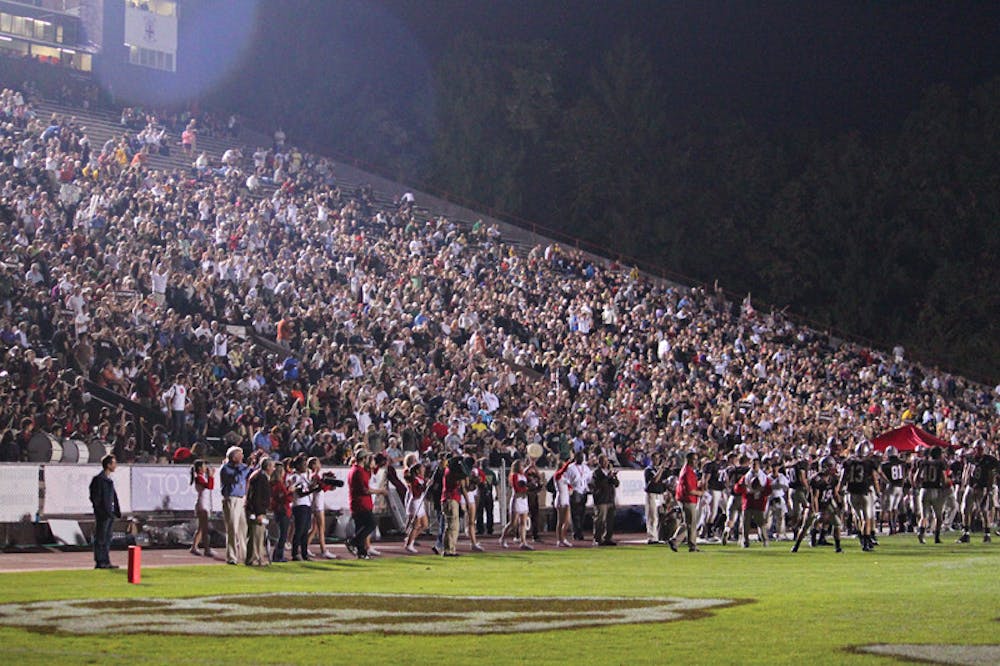Three quarters of undergraduate students reported attending an extracurricular event in the performing or visual arts at least once per month, whereas only a third said they attend varsity sporting events with the same regularity, according to a Herald poll conducted last month.
Over 30 percent of respondents never attend sporting events, but only 5 percent of students never attend arts events.
But, these trends were not universal among all students. Of students who reported playing on a varsity sports team, 86 percent attend games once per month or more, compared to only 22 percent of non-athletes.
Athletic Director Jack Hayes said it is important for universities to offer a variety of events for students to attend and activities that engage attendees.
“We encourage our student-athletes to go to as many non-athletics events as possible,” Hayes said.
Students responding to the poll results described a fundamentally arts-oriented campus culture without a strong sense of school spirit for sports teams.
“We are a pretty artsy school,” said Kirsten Belinsky ’15, who plays on the women’s soccer team. “Brown isn’t known for its athletics.”
“When people go to the gallery or something in the (Perry and Marty Granoff Center for the Creative Arts), it feels like a very authentically Brown experience,” said Brette Ragland ’13, board member of Sock and Buskin and Musical Forum, “while going to a football game doesn’t feel that way.”
Abigail Jones ’15, member of the women’s cross country and track teams, agrees that the arts have a larger following than sports. “If I could change anything about Brown, it would be more school spirit,” she said.
Jane Lancaster PhD’98, campus historian, said the perception of Brown as “artsy” may be a relatively recent phenomenon, possibly because of the incorporation of the visual and performing arts into formal academic departments during curriculum reform in the ’60s and ’70s.
“I don’t see Brown students as particularly sporty,” she added.
“Sports really aren’t on everybody’s radar here,” said Naomi Varnis ’16. “I really think that’s just the nature of the school that Brown is. If you wanted sports, you’d go to a big sports school, like the University of Texas or (the University of Mississippi).”
Leslie Bostrom, professor of visual arts and department chair, attributes attendance at sporting events to student’s desires to participate in a community.
“It’s very different with art. Both things are personal, but (the arts experience) is not as tribal. It’s more individual in a sense,” she added.
Students said athletes operate on different schedules and within separate social circles, affecting their interactions with the rest of the student body.
“The theater community and the sports community are both really self-selecting, isolating communities that only hang out with each other,” Ragland said.
“I think the (athletic) community runs on tighter circles, so athletes will support each other more so than non-athletes,” Belinsky said.
Jones said she observed trends in attendance at her own meets that support the poll’s findings. “As an athlete you expect to see your fellow (students) at sporting events, but the attendance is not always very good,” she said. “Even though the attendance isn’t great at sporting events,” most of the sparse crowd is populated by athletes, she said.
Other students raised issues of accessibility and convenience for different types of events.
Attending an a cappella concert or a theater performance is “much more accessible than a several hour long sports event in the middle of the day,” said Nate Wardwell ’14, former “Czar” of the Intergalactic Community of A Cappella, an umbrella organization for a cappella ensembles on campus. “The performing arts scene just sort of fits better into day-to-day life than the sports scene does,” he said, commenting on student’s busy schedules and many commitments.
“When you go to a sports event, you really commit two to three hours of your time, whereas you can go into (David Winton Bell Gallery) and be there for five minutes and see part of the show and come back out,” Bostrom said.
Attendance can be attributed to event timing and publicity, Hayes said. Even though events may be well-publicized, it is also a challenge to find times when everyone can go, he added.
“People don’t come to Brown because of athletics per se, but at the same time there have been a couple of football games where the attendance was great, like the Harvard game, so it just shows there is potential for Brown students to be interested in athletics,” said football player Patrick O’Neill ’15.
“The night games are something that attract more students to attend, and there should be more included to get more attendance at athletics events,” said Brian Barr ’15, a member of the swim team.
Students said extracurricular events in the arts and sports are supplementary to their academic commitments.
“You know the phrase, ‘Work hard, play hard?’” Wardwell said. “I think it means that (when) people ... get down to work ... they buckle into it, and then they’ll set aside time to be social.”

ADVERTISEMENT




